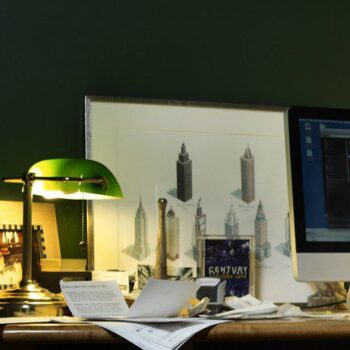
Kurt Andersen
Place: Kurt’s home office, Brooklyn, New York
Click image to enlarge.
***
When I was young I mostly wrote in places without any real privacy—an old-fashioned newsroom, a half-open hallway, downtown loft workspaces, a small apartment. I tuned out the other people, as one does. And every office space provided by employers over the years, whether grand and wood-paneled or standard-issue monochrome cubicle, I’ve kept un-personalized, devoid of artwork, knick-knacks, family pictures—not on principle, at least not conscious principle, but rather because those places felt (and inevitably were) temporary.
Not long before I started writing fiction for several hours every morning, my wife and I moved into a house in Brooklyn, with a spare room that could and did become my dedicated workspace. There’s a chicken-and-egg question here: did having my own room to write enable me finally to produce novels (the freedom of an inviolate trance venue? the pressure to make good on the precious New York real estate allocation and produce?) or did switching from mostly short non-fiction to mostly long fiction require that I occupy a little fortress, a space just for me? All of the above, I think.
In any case, for me writing well and at length now requires walled-off, closed-door privacy as much as it does a computer. I would much sooner have door-free bathrooms than a door-free writing space.
I call it “the green room” more than I do “my office”—maybe because I don’t think of imaginative leaps and occasional creative miracles happening in an office. It’s the messiest room in our house by far—maybe because the meaningful clutter makes it feel like a simulacrum of my mind, maybe because the mess is a cozy signifier of privacy, maybe because the clutter seems pre-modern, like novel-writing.
Copies of the books I’ve published and magazines I’ve edited are within right-arm’s length, perpetually in my peripheral vision as I write. Copies of TV shows I’ve written and produced are above me. Books by other people fill five eight-foot-long shelves behind me, the work of predecessors and peers and giants on whose shoulders I stand looming out of view. I’m always glancingly aware of the outside world—trees, sun, wind, neighbors, voices of children walking to and from the school at the end of the block—through the tall window to my right.
What I don’t see as I’m writing, and what you don’t see here, are two comfortable blue velvet armchairs. In those I take breaks sometimes to think and read, away from the glowing, demanding screen.
***
Photo by: Brad DeCecco





